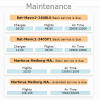Chip
Well-Known Member
- Joined
- Sep 11, 2017
- Messages
- 2,192
- Reactions
- 2,713
I need to restate that. I believe the graph is saying that the statistical incidence of propellers falling off UAVs occurs with “average” frequency on worldwide basis. Sure would like to see the supporting data on that one.










